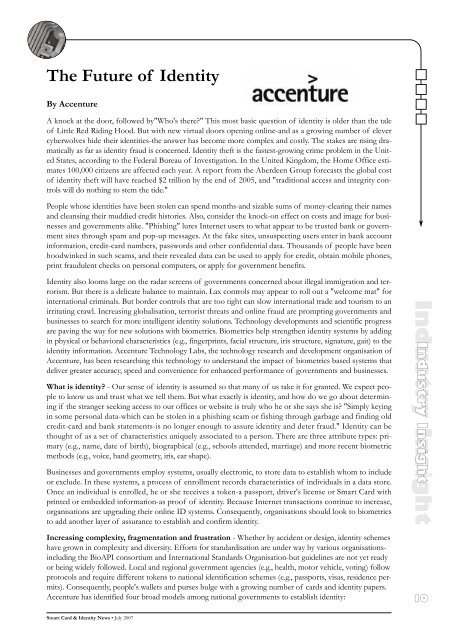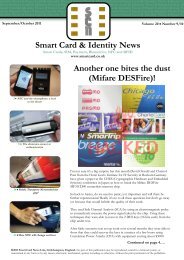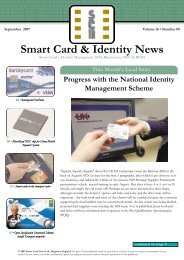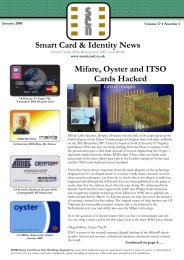Smart Card Identity News - Smart Card News
Smart Card Identity News - Smart Card News
Smart Card Identity News - Smart Card News
Create successful ePaper yourself
Turn your PDF publications into a flip-book with our unique Google optimized e-Paper software.
The Future of <strong>Identity</strong><br />
By Accenture<br />
A knock at the door, followed by"Who's there?" This most basic question of identity is older than the tale<br />
of Little Red Riding Hood. But with new virtual doors opening online-and as a growing number of clever<br />
cyberwolves hide their identities-the answer has become more complex and costly. The stakes are rising dramatically<br />
as far as identity fraud is concerned. <strong>Identity</strong> theft is the fastest-growing crime problem in the United<br />
States, according to the Federal Bureau of Investigation. In the United Kingdom, the Home Office estimates<br />
100,000 citizens are affected each year. A report from the Aberdeen Group forecasts the global cost<br />
of identity theft will have reached $2 trillion by the end of 2005, and "traditional access and integrity controls<br />
will do nothing to stem the tide."<br />
People whose identities have been stolen can spend months-and sizable sums of money-clearing their names<br />
and cleansing their muddied credit histories. Also, consider the knock-on effect on costs and image for businesses<br />
and governments alike. "Phishing" lures Internet users to what appear to be trusted bank or government<br />
sites through spam and pop-up messages. At the fake sites, unsuspecting users enter in bank account<br />
information, credit-card numbers, passwords and other confidential data. Thousands of people have been<br />
hoodwinked in such scams, and their revealed data can be used to apply for credit, obtain mobile phones,<br />
print fraudulent checks on personal computers, or apply for government benefits.<br />
<strong>Identity</strong> also looms large on the radar screens of governments concerned about illegal immigration and terrorism.<br />
But there is a delicate balance to maintain. Lax controls may appear to roll out a "welcome mat" for<br />
international criminals. But border controls that are too tight can slow international trade and tourism to an<br />
irritating crawl. Increasing globalisation, terrorist threats and online fraud are prompting governments and<br />
businesses to search for more intelligent identity solutions. Technology developments and scientific progress<br />
are paving the way for new solutions with biometrics. Biometrics help strengthen identity systems by adding<br />
in physical or behavioral characteristics (e.g., fingerprints, facial structure, iris structure, signature, gait) to the<br />
identity information. Accenture Technology Labs, the technology research and development organisation of<br />
Accenture, has been researching this technology to understand the impact of biometrics based systems that<br />
deliver greater accuracy, speed and convenience for enhanced performance of governments and businesses.<br />
What is identity? - Our sense of identity is assumed so that many of us take it for granted. We expect people<br />
to know us and trust what we tell them. But what exactly is identity, and how do we go about determining<br />
if the stranger seeking access to our offices or website is truly who he or she says she is? "Simply keying<br />
in some personal data-which can be stolen in a phishing scam or fishing through garbage and finding old<br />
credit-card and bank statements-is no longer enough to assure identity and deter fraud." <strong>Identity</strong> can be<br />
thought of as a set of characteristics uniquely associated to a person. There are three attribute types: primary<br />
(e.g., name, date of birth), biographical (e.g., schools attended, marriage) and more recent biometric<br />
methods (e.g., voice, hand geometry, iris, ear shape).<br />
Businesses and governments employ systems, usually electronic, to store data to establish whom to include<br />
or exclude. In these systems, a process of enrollment records characteristics of individuals in a data store.<br />
Once an individual is enrolled, he or she receives a token-a passport, driver's license or <strong>Smart</strong> <strong>Card</strong> with<br />
printed or embedded information-as proof of identity. Because Internet transactions continue to increase,<br />
organisations are upgrading their online ID systems. Consequently, organisations should look to biometrics<br />
to add another layer of assurance to establish and confirm identity.<br />
Industry Insight<br />
Increasing complexity, fragmentation and frustration - Whether by accident or design, identity schemes<br />
have grown in complexity and diversity. Efforts for standardisation are under way by various organisationsincluding<br />
the BioAPI consortium and International Standards Organisation-but guidelines are not yet ready<br />
or being widely followed. Local and regional government agencies (e.g., health, motor vehicle, voting) follow<br />
protocols and require different tokens to national identification schemes (e.g., passports, visas, residence permits).<br />
Consequently, people's wallets and purses bulge with a growing number of cards and identity papers.<br />
Accenture has identified four broad models among national governments to establish identity:<br />
10<br />
<strong>Smart</strong> <strong>Card</strong> & <strong>Identity</strong> <strong>News</strong> • July 2007
















